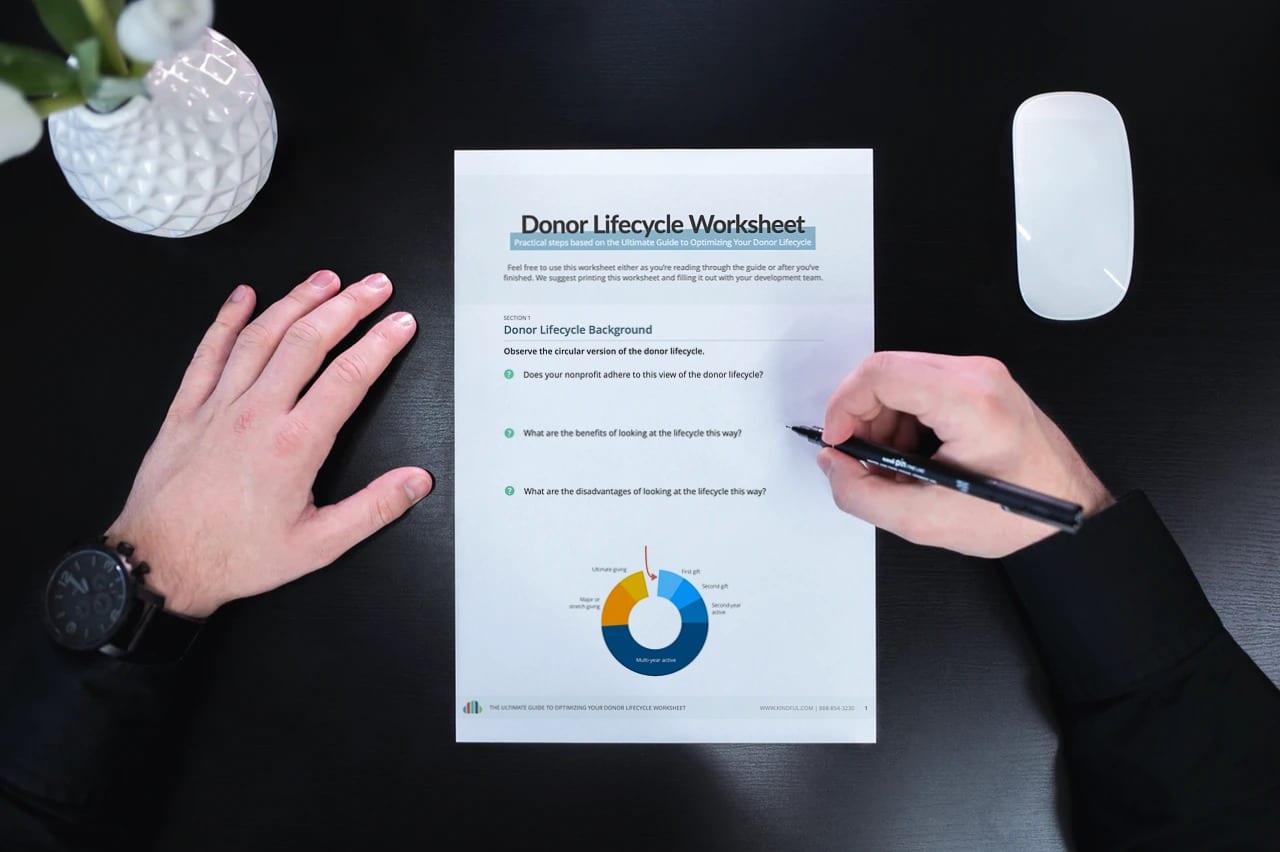It’s never been more important to evaluate how effective your fundraising efforts are. In this guide, we explore why understanding the donor lifecycle is critical to the success of every nonprofit.
Keep reading to learn about the donor lifecycle, how it can help you better understand your donors, improve your donor relationships, and act on the data you’ve collected.
- Looking At The Donor Lifecycle
- Donor Acquisition
- Donor Retention
- Donor Upgrade
- How To Use The Donor Lifecycle
- Bonus: Free Donor Lifecycle Worksheet
1. Looking At The Donor Lifecycle
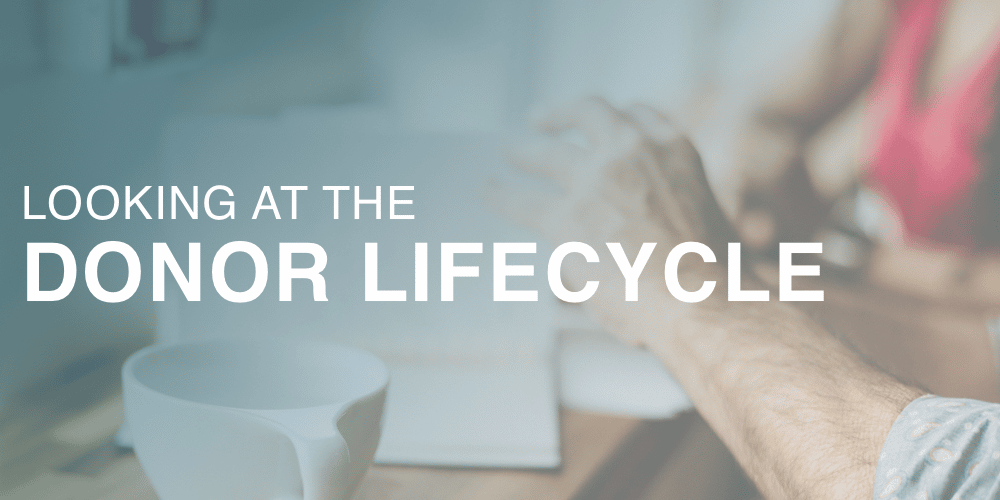
The donor lifecycle has a handful of explanations from various sources that have led to several misconceptions about what it actually is. Some view it as an actual lifecycle, like a closed loop—a donor hears about the organization, eventually gives, and is then cultivated until they give again. That’s a fairly condensed version, but the idea of a loop—from awareness to cultivation to gift—is an extremely prominent model.
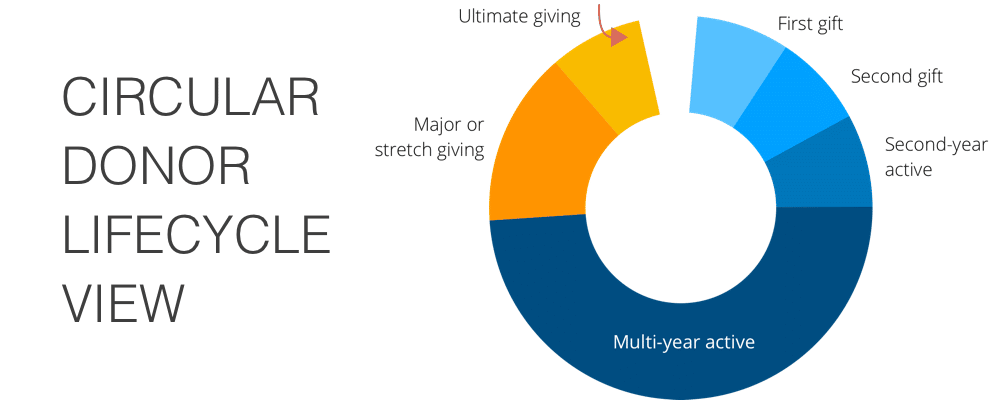
The oversight of viewing the lifecycle as circular is that a donor’s path can branch out at many points. A donor can lapse, for one. Similarly, your nonprofit’s goal isn’t just to get them to give again and recycle the loop. Your goal is to get them to engage deeper – giving more year over year, becoming a recurring donor (or recurring giver) or becoming a major giver.
Through the stages of engagement, newly acquired contacts should turn into first-time donors. These donors should be cultivated to increase interest, preventing opportunities to lapse. As time goes on, donors should eventually elevate to giving more – relative to their abilities – and finally, truly advocating for your mission. This is why we suggest a more linear model of analyzing the donor stages.
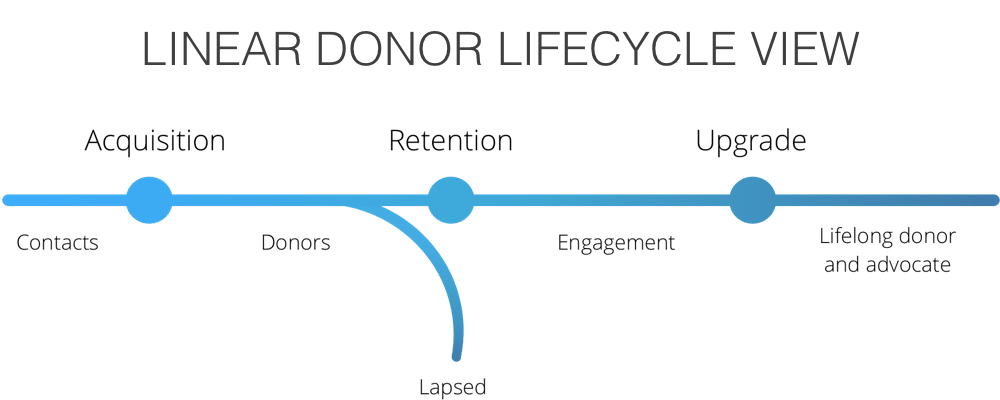
What Are The Three Stages Of The Donor Lifecycle?
As you engage with your donors, creating lifelong givers is what you’re striving for. The three stages of the donor lifecycle are donor acquisition, donor retention, and donor upgrade.
- Donor Acquisition: Collecting contacts to cultivate into donors, and welcoming new donors to your organization
- Donor Retention: Keeping donors engaged to prevent them from lapsing
- Donor Upgrade: Continuing to cultivate your donor relationships and inspire recurring or major givers
This view of the donor lifecycle breaks the stages down into three sections centered around giving: pre/early giving, lapsed givers, and elevating givers. By analyzing these 3 stages of donations, it becomes clear who needs to be communicated with to grow your giving.
Problem: Don’t Focus Only On Donor Retention
We’ve noticed a huge emphasis on retention in the nonprofit market. This focus isn’t bad by any means, since retention is a metric that can be easily measured and acted upon.
But retention doesn’t tell the whole story.
If retention is the only part of the lifecycle you concentrate on, you’ll lose all your donors. If you’re retaining donors to become lifelong donors, that’s great, but they’re only lifelong donors. What happens when your big constituency of baby boomers begins to age out, and your donor base is now dramatically reduced because you’ve only focused on keeping your donors, not getting new ones?
If you’re not acquiring new donors, you’re missing out on future growth, and potentially even survival.

With a focus on acquiring new donors, however, you’ll spend all your time and energy up front, only to get a single gift. What if that gift is small? What if they don’t give again? With so much time and financial resources that go into fundraising campaigns, it’s important you’re getting a positive return on those efforts. Which is why it’s so important to make sure that donor gives again, since a second gift costs you less than the first.
Similarly, if you focus only on upgrading the donors you have, your donors will get burned out. There’s so much discussion in the nonprofit world today around treating donors like ATMs. This treatment is the easiest way to crank up your attrition rate.
Can you see why it’s detrimental to your organization to focus on only one of these lifecycle stages?
Solution: Segment Donors Using All Three Stages Of The Donor Lifecycle
The lifecycle is at its best when viewed holistically. As we just laid out, it’s short-sighted – and potentially harmful to your organization – to place emphasis on only one of the stages. But when you can segment your donors into the various stages, and develop strategies to nurture them into a higher level of engagement, then you can engender real growth.
In the remainder of this guide, we’ll explore each stage of the donor lifecycle (donor acquisition, donor retention, and donor upgrade) in detail. We’ll accompany definitions with metrics you should monitor, and industry averages to which you can compare.
After providing detail to each stage, we’ll go over some actual steps for you to gather your data, report on these metrics, and make better fundraising decisions.
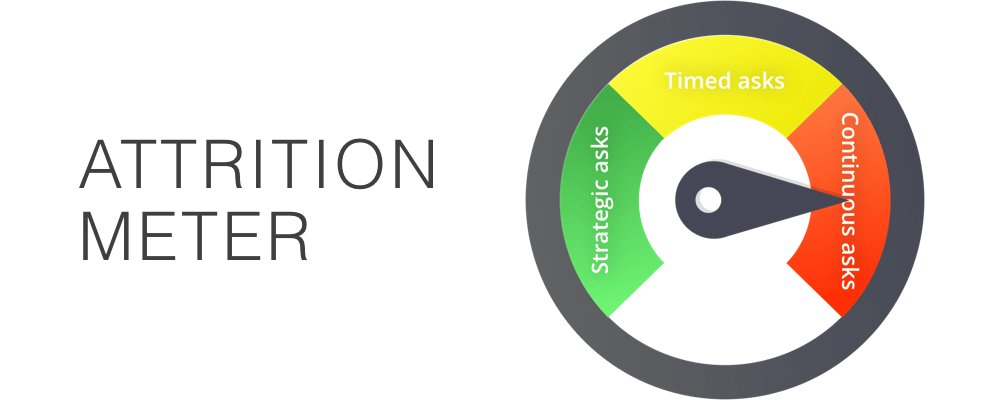
2. Donor Acquisition

What Is Donor Acquisition?
Donor acquisition is the process of obtaining new donors or contacts through fundraising and marketing efforts.
Acquiring new donors or contacts gives you a pulse on how well your fundraising and marketing efforts are converting. This can help inform where more resources should be placed.
There’s an important distinction here between donors and contacts. Acquiring new donors is the ultimate goal. Once you can get someone to give, all those marketing efforts become worthwhile. And it should be easier to get them to give again now that they’re past the first-gift barrier.
In terms of marketing, contacts are just as important to focus on as donors. They shouldn’t receive extremely specific attention just yet, but they should be receiving quite a bit of attention. Your goal is to continue to introduce them to your organization, show them what impact you’re making, and nurture them toward a first gift.

3 Metrics You Need To Measure Acquisition
1. How To Calculate Your Contact Acquisition Rate
Analyzing the very beginning stages, there are several donor metrics to determine how well your marketing efforts are gathering new contacts. One way to measure acquisition is by gauging new contacts added to your database month over month or year over year. You can measure that against the resources you’re putting toward marketing campaigns, like speaking engagements, events, content downloads, etc.
Measuring contact growth from one month to the next can be touch-and-go. Don’t get too caught up in the monthly ebbs and flows. If you don’t have consistent marketing initiatives, you can see a lot of fluctuation month to month.
For example, if you have a yearly race, you may get a huge influx of contacts surrounding the event. If you hold such an event yearly, it’s better to compare the measure of new contacts from the previous year to current. Or if you have 2 events a year, it will be helpful to compare against the previous year, as well as the previous event, to see how well you’re improving your acquisition.
2. How To Calculate Your Donor Acquisition Rate
A great way to measure donor acquisition over time is join date versus first donation date, with join date being when that contact was added to your database. Tracking this day range over time can help you see how well you’re improving your nurturing. If the number of days between collecting their info and gaining a donation decreases, that means you’re optimizing your nurturing process.
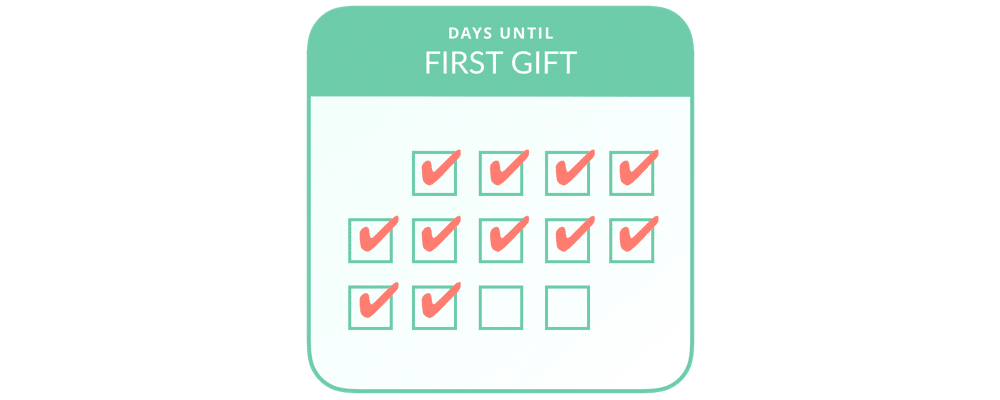
3. How To Calculate Your Donor Conversion Rate
Similarly, tracking overall donor conversion rate is another good practice. Seeing the average number of days it takes for someone to go from contact to a new donor helps give you a baseline for how long they need to be nurtured. But it’s also important to track how many contacts convert into new donors. You can calculate your donor conversion rate by dividing the number of converted donors by total contacts. This number will let you know if you’re nurturing the right people in the right ways.
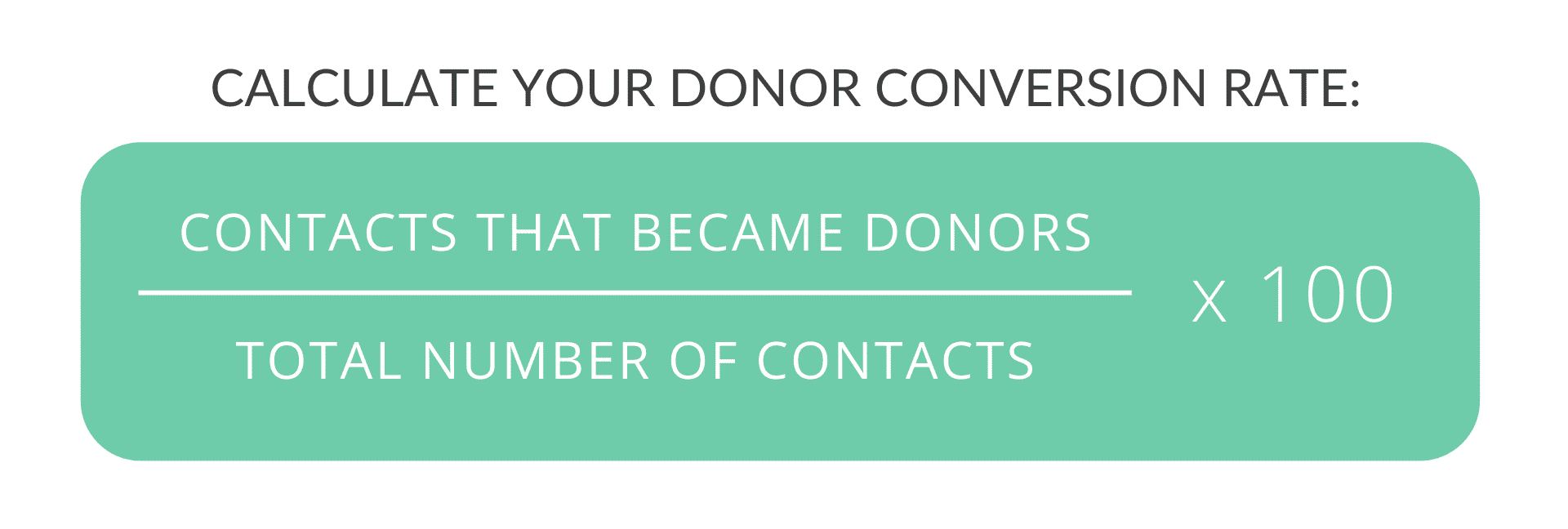
Another great way to look at donor and contact acquisition is by channel. By taking a very analytical approach to your fundraising, you can determine which initiatives you want to boost, which you want to cease, and which need some tender love and care.
Acquisition Channels
Here are a few fundraising and participation channels you can analyze for your donor and contact conversion rates:
Events
- By participant
- By team leader, table host, etc.
- By levels of participation
- By event (eg Spring Gala vs 5k)
Campaigns (What People Are Giving Toward)
- Building fund
- Scholarship fund
- Recurring membership
- “Daily” gifts
Source
- In-person meetings
- Phone calls
- Events
- Direct mail appeal
- Website
- Online advertising
- Advocacy
- Social media / online engagement
- Volunteering for your organization
- Referral partner (encouraging others to get involved with your organization)
What Do You Do With Your New Contacts & Donors?
Since these constituents are brand new to your organization, the first thing you can do with new contact and donors is welcome them.
In general, these new contacts or donors need to be placed into a welcome email series. This is an easily automatable series of emails that anyone new to your database can be placed in for them to learn more about your organization, showing what your mission is, who/what is benefiting, and what their gift would go toward.
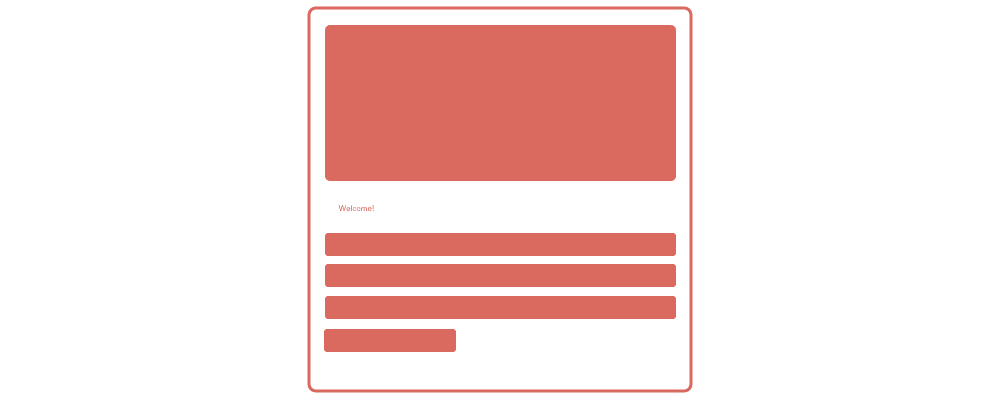
Your nonprofit should also determine your response strategy for different types of donors. Recurring or major donors should receive different attention than other givers, This strategy will depend on the size of your organization as well as the size of gifts. Set a threshold for various giving amounts and decide what actions follow (e.g. new recurring donors get a handwritten thank-you note, all first-time donors of $1k or more get a personal call from the Director of Development / Engagement).
Based on what metrics you have access to, this is also a good time to analyze your marketing and digital advertising initiatives. Is your timeframe for converting a contact into a donor increasing? If so, it might be time to look at how you’re engaging with new contacts in your database. Is your new contact count waning? A look at new marketing initiatives might be in store.
What Is A Good Donor Acquisition Rate?
Here are some stats from the nonprofit industry to stack up your donor acquisition rate against. If your ongoing metrics aren’t shaping up to these standards, it’s time to take a look at your fundraising and determine the weak link.
- On average, 1.1% of website visitors should join your email list.
- On average, 1.2% of website visitors should donate.
- The average conversion rate for fundraising emails is 0.04%.
- The average nonprofit’s email list grows 10% per year.
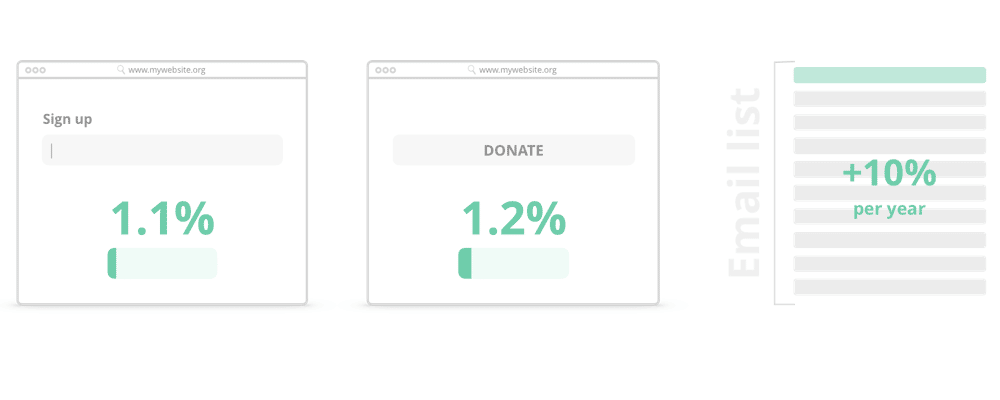
3. Donor Retention

What Is Donor Retention?
Donor retention is the process of preventing donors from lapsing in their gift giving, typically from one year to the next.
The cost of acquiring a donor is huge. Some stats show that, on average, it can cost an organization between $0.25 and $1.50 for every $1 raised. Yes – that means to acquire new donors, you could be losing money. And while the previous chapter highlighted why it’s still important to go after new donors, if you don’t keep them engaged and giving, you’re throwing money away.
The easiest way to retain a donor is by encouraging a giving schedule. The first step is making sure your online fundraising platform can set up recurring donations, or at least track recurring gifts that come in the mail. But once you have that ability to set a donor on a timed payment schedule, then they’re likely to give again next year simply because their card hasn’t changed.
Once a donor has crossed the threshold of giving for the first time, it’s instantly easier to get them to give again.
There’s at least some basis of relationship created from the first gift, and, if nurtured well, that relationship will grow. This is where modern digital marketing can be your best friend.
With the use of email and social marketing tools, you can nurture all your donors at the same time. Newsletters, social media engagement, thank-you emails for gifts given. All these efforts help engage and retain donors – and many of them are automatic or broad enough to apply to all donors.
This is why so many experts out there hone in on retention. It can really help sustain your nonprofit, and protect the bulk of your fundraising income.

How Do You Calculate Your Donor Retention Rate?
Retention metrics often use the term “lapsed” to describe a donor that hasn’t given for x amount of time. If a donor has lapsed over time, then you haven’t retained them. That means you can calculate your donor retention rate by measuring the amount of donors that have given more than one time in the current year divided by all previous donors from the year before. Then simply multiply by 100 to get your percentage.

Most often, this time frame is viewed in a calendar year. However, it can be really helpful to look for donors that gave a little over a year ago on a monthly basis. This can show you donors “at-risk” of lapsing in giving, and may be more helpful than starting fresh at the beginning of a calendar year.
Along those lines, looking at when donors are about to lapse is a great time to send them an appeal. You could reach out and say, “Last year you gave this much, and it helped us accomplish this thing. Would you consider giving this much this year to help us do this thing?” This messaging contextualizes their previous giving, and shows ways they both have made an impact and can make an impact.
For many organizations, signs of success can look different based on your nonprofit’s size.
Typically for smaller organizations, donors giving more than once (no matter the amount) is a great sign of retention. For larger organizations, your organization may determine that giving at least the same amount 1-2 years after the first gift is a good trend.
It’s also a good idea to measure donor engagement. Are your donors showing up at events? Are they opening your emails? With a good donor management platform, you should be able to measure (and report on) these metrics, showing your donors’ levels of engagement. This is another measure of retention. Sure, they may not be giving financially, but if they’re giving with their time or other resources, that means you’re doing something right.
How Do You Improve Your Donor Retention Rate?
There’s plenty of material on the Internet about how to improve donor retention. A very simple Google search would glean hundreds (if not thousands) of results on how to increase your donor retention. We have a few ideas that you can accomplish using your donor management platform.
The primary way to improve your donor retention rate is to emotionally connect with your donors. Foster a relationship with them. Make them feel needed. Make them feel like they’re making a difference. Make them feel valued – because they are!
4 Strategies To Improve Donor Retention
1. Make sure all your donors are receiving thank-you emails.
This is an easy thing to automate while going a long way in nurturing your donor relationships. Show them how their gift is making an impact. You could even take this a step further and talk about the specific project their gift is contributing to.
2. If you can, call your first-time donors.
And if you don’t have the resources, you should at least be calling first-time donors above a higher gift amount (relative to your organization). This is easy for board members or volunteers to do very quickly. This will also help you get a pulse on how the donor heard about your organization, which goes back to informing your acquisition efforts.
3. Use reports to see who is in danger of lapsing.
Reach out to the donors who are lapsing to 1) remind them of their donation last year, 2) inform them how they made a difference by donating, and 3) invite them to make a difference again this year, that can be a huge step to retain those donors.
Keep in mind that if a donor hasn’t heard from you in a year, and you’re reaching out to them again for an appeal, it’s very unlikely you’ll receive a donation. There has to be continued communication to build a healthy donor relationship. The more a donor can trust the work you’re doing, and feel like they’re actually part of the process, the better your fundraising and retention will be.
4. Take a look at the trend of donors that are lapsing.
Is there a common thread between these people? See what campaigns they gave toward. See what channels they gave through (website, social media, ads, events, etc.). Or check gift amounts. If you can isolate a commonality in this group of donors, you can discover where your engagement may be weak.

How Good Is Your Donor Retention Rate?
These averages from the nonprofit sector are generic guidelines. Retention depends significantly on the size of your organization, the sector your work is in, and how long you’ve been around. With that said, here are some stats to measure your donor retention rate against:
- Over the last 10 years, the average donor retention rate has consistently stayed under 50%.
- For every 100 donors gained, typically 99 donors are lost due to attrition.
- The average donor retention rate is 45%.
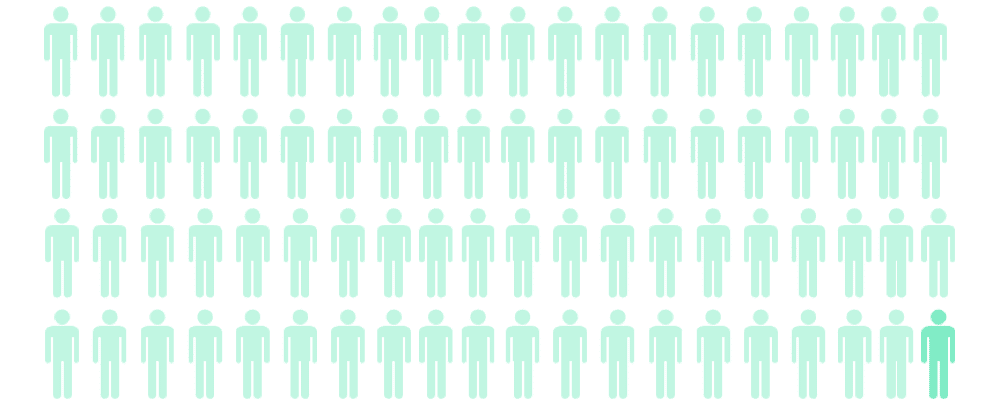
4. Donor Upgrade

What Is Donor Upgrade?
Donor upgrade is the process of increasing a donor’s giving from one year to the next.
Just because a donor is engaged with your organization doesn’t mean their journey is over. Often, it’s these donors that can become your nonprofit’s greatest assets.
While donor upgrade does involve increasing a donor’s giving, this isn’t exclusive to financial gifts. Yes, financial gifts may be the easiest thing to track about your donors, but, to consider the bigger picture, it’s important to look at donors’ giving attention to your nonprofit.
The more a constituent can be involved with your nonprofit, the more they’re likely to give, and the more they’re likely to advocate and spread your fundraising to others. Take peer-to-peer campaigns as an example. They are a prime example of donors taking next steps to further your mission.
Look at how donors are interacting with your organization. The goal is upgrading a donor’s gift of time, interest, passion, and attention, as well as resources.

How Do You Measure Your Donor Upgrade Rate?
As stated in the last section, it’s easiest to measure how donors are upgrading financially. You can measure your donor upgrade rate simply by calculating which donors gave more this year than the last year. If a donor gave a total of $100 last year, and then gave $125 this year, congratulations – you’ve got an upgraded donor.
You can also measure your donor upgrade rate by counting the number of donors who gave a one-time gift in last year but upgraded to a recurring gift in this year. This should naturally result in giving more year over year, since that’s 12 gifts instead of 1.
Look for upgrading trends, not just how many donors are upgrading. Try to measure what the average first gift amount was for those who upgraded in subsequent years. Or look at what campaigns upgraded donors gave to, or if your upgraded donors tend to open your monthly newsletter.
By looking at your upgraded donors through the trend lens, you can start to see what’s working, and implement that into your fundraising strategy to upgrade even more donors.
Upgrading donors is vital to your organization. In fact, you get two for the price of 1—increase your retention rate and increase donations. If you’re not actively optimizing this process, you’re missing out on the largest untapped potential for your donor base.
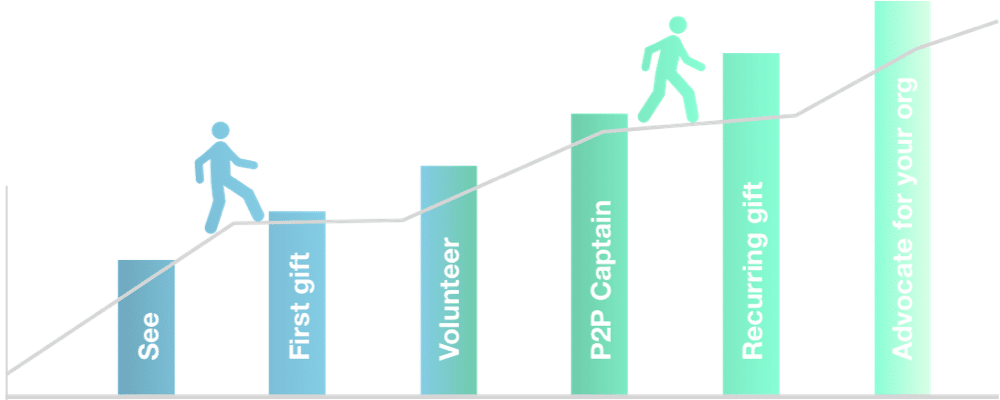
How Do You Upgrade Your Donors?
When looking at a broad group of donors, there is one word you need to remember: segmentation.
Segmenting your donors into groups of similar giving is the easiest way to encourage growth and upgrade your donors.
Think about your lowest-level donors. Depending on your organization, these donors’ gifts could range from $10 to $200. Regardless of the amount, you can look at your lowest tier, put those donors into a group, and communicate with clear next steps. If that donor gave less than $50, invite them to give $50. Less than $100, invite them to give $100. Then you can work your way up the varying tiers, and encourage gifts in larger leaps.
This specific targeting requires that you take the time and effort to make sure your systems are tracking your donor data in the right ways. Segmenting can be really easy when you have the systems to support it. And, as your database grows, so do these groups – making it even more efficient to succeed with mass communications.
Apart from your general donor audience, there are two simple, quantifiable goals for upgrading donors: create recurring and major givers.
How Do You Create Recurring Donors?
Recurring donors, or recurring givers, are the bread and butter for most nonprofit organizations. It’s like having a subscription service for your nonprofit. Dependable, consistent income. The more recurring donors you can develop, the more secure your organization’s foundation can become.
There are some great ways to segment donors that may be ready to upgrade. If, for example, a donor gave the same amount year over year, it’d be great to follow that up with upgrade messaging. If they gave $100 both years, you could write to them, and ask to switch their single donation to a $10 donation every month. Not only are you converting that donor into a recurring giver at that point (and thus improving your retention), but now you’ve also increased their giving amount by $20.
Another way to flag a potential recurring candidate is a donor that’s given multiple times in the same year. Especially if they’ve given to the same campaign multiple times. This shows that your mission really aligns with their values, and they may be willing to give more often.
How Do You Create Major Donors?
While upgrading recurring donors can be systematic (i.e. segmenting, targeting, and emailing), upgrading major donors must be relational.
When a donor chooses to give a large amount, that gift must be returned with extreme gratitude. On that first thank-you call or visit, this is a great opportunity to find out 1) how they heard about your organization, 2) why they chose to give, and 3) if they’d be interested in giving again in the future.
Yes – you may actually find a major donor’s upgrade potential right after their first gift. Of course, you could also use a wealth screening tool. But a relationship will produce way more dividends than a screening.
Major donors also love seeing their money grow. To make the most of this, you can incentivize a major donor to provide a match for an upcoming fundraiser or campaign. Creating a matching gift program with a major donor is a win-win. The matching gift encourages your donor base to consider potentially giving more than they have in the past, and it provides an extra nudge to first-time donors to make their initial gift.
In addition, the major donor enjoys seeing their matching commitment grow the overall funding for that specific initiative.
Another route would be to make the most of both groups of potential upgrading donors with a program that matches the first month of a new recurring donation. The major donor’s gift is matched, and a donor that may have been close to upgrading their giving now has even more incentive.
How Good Is Your Donor Upgrade Rate?
Let’s look at some statistics around upgrading donors, recurring donors, and major givers.
- 88% of total dollars raised come from 12% of donors. Monthly giving accounts for 17% of all online revenue.
- On average, a recurring donor gives 42% more per year than one-time donors.
- $27 is the average monthly donation.
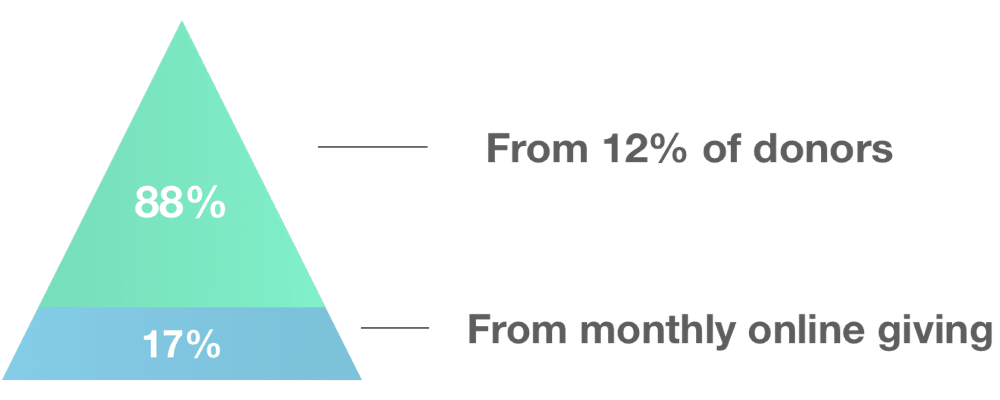
5. How To Use The Donor Lifecycle
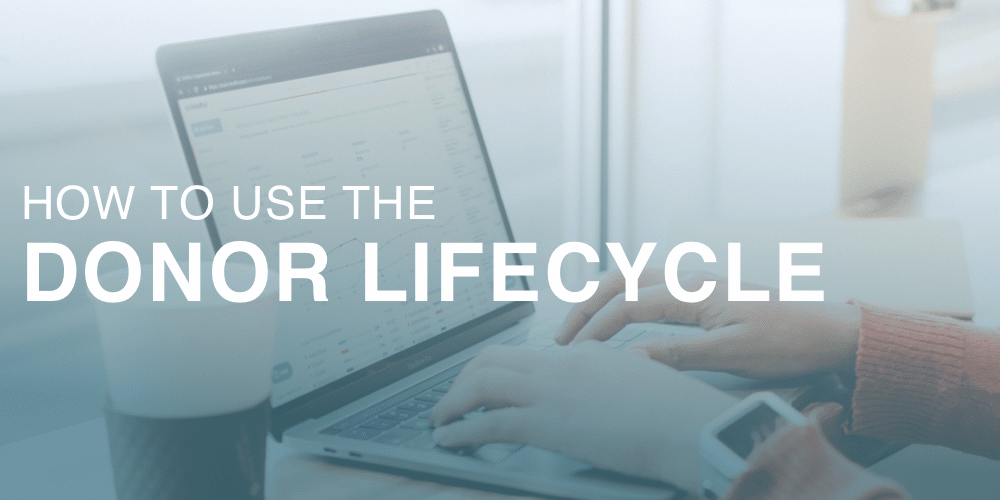
We’ve just discussed three stages of the donor lifecycle, why you should monitor them, how to measure them, and what you’re looking for when analyzing your reports. That’s great and all, but what to do with all that theory? How do you monitor all these reports at the same time?
Let’s get practical with four steps.
1. Track Your Donors
First thing’s first: if you’re not tracking as much of your donor interactions as you can, you’re missing out on tons of opportunity to improve your fundraising.
Before you can start collecting donor data, you need to make sure the tools you use and systems you have in place can actually collect that data. Set up your campaigns and tracking in the clearest, most complete ways.
If you have a way to use some type of source tracker, then you’re already a step ahead. Being able to decipher where your fundraising success is coming from (email appeals, social media, website traffic) is vital to affecting your acquisition, retention, and upgrade levels. Having the ability to log phone calls, in-person meetings, and other physical interactions are essential as well.
If you don’t have a way to track these sources and collect data in this way, you could divide your campaigns based not only on where the funds are going, but based on the source. For example, if you have a building fund you’re marketing, you could divide your campaigns by source, using “Building Fund” as the base, then adding “Direct Mail”, “Website”, or “Peer-to-peer” to the end of the base campaign. This will allow you to track how your fundraising is doing, and allow you to analyze down the lifecycle how the various sources are retaining and improving donor experiences.
Tracking online donations can be a great way to utilize Google Analytics. Not only can this help you determine where your online donors are coming from, but it can indicate the success of your donation pages and overall donor experience.
You should also try to collect non-fundraising data about your constituents. Email deliverability and opens, events they’ve attended, ways they’ve volunteered. All this will help provide a better picture when you’re reporting.
2. Organize Your Donor Data
If you don’t have a central place for all your data to gather, you’re in dire need of a donor management platform.
Collecting your data in a central database is vital to tracking the donor lifecycle. It can’t be limited to just fundraising data. You’ll have a shortsighted view of your donors if you’re only taking donation data into account.
Using a donor database, you can now make sure your donor and constituent records have complete and accurate history. The best donor databases will automatically import data from your various sources, compiling this data into single donor records. Now each constituent profile should show their complete history of engagement with your organization.
3. Segment And Report Your Donor Data
With all your donor data organized in a single database, segmenting similar donors into groups should be easy. Not to say that deciding how you should group people is easy, but the act of segmenting will at least be straightforward.
Here’s where you should take the measuring sections from the above chapters and create segments, groups, and reports based on each stage of the donor lifecycle. Set up recurring reports to show you how many new contacts you collected over the last month, a list of first-time donors to call, donors that are weeks away from lapsing, or donors that have exhibited specific behaviors that show upgrade potential.
With the right donor management platform, setting up recurring reports is a breeze. Now you have your data in the right place, knowledge of what you should measure, and ideas about what you could analyze to improve some of your metrics.
4. Act On Your Results
This is where the real effort comes in. It’s time to get to work! Here’s a recap with some ideas for acting on your results.
When measuring and acting on your acquisition metrics, this is an opportunity to tighten up and optimize your marketing efforts. Analyze what channels are performing well, figure out why, and use that to improve other channels. As you begin optimizing, take inventory of your conversion rates now, so you can see if the changes you’re making are improving your conversion for first-time donors. This is also a great time to brainstorm new ideas!
Looking at retention, there are some very clear steps. First, there are always donors close to lapsing – so develop an outreach process and start communicating! Use email cultivation to do things like announce the anniversary of their gift and how that gift has influenced your cause is a great start. Phone calls and handwritten notes also go a long way in strengthening your donor relationships.
This might also be a good time to start whiteboarding your entire donor experience. Ask questions like, “Are these donors lapsing because we’re not welcoming them properly?” or, “Are donors aware of how they’re making a difference?” Retention shouldn’t inspire only an emergency response just as they’re lapsing. This should add to the bigger picture, showing you how you can improve the donor experience after acquisition.
Finally, take a look at how your donors are engaging to see who can be upgraded!
Set up monthly reports to show you donors engaged across the board: donors with volunteer hours, email opens, occasional donations, event attendance, etc. Examine trends in your already upgrading donors – what campaigns they first gave toward, what amounts they initially gave. This will give you great next steps to find upgradable donors.
Donor Lifecycle Made Easy
For some of you reading this, your first step might actually be to look into a donor management platform. This is where you can track your donation data like your donors, contacts, transactions, and interactions—all in one place. Good donor management platforms allow you to filter and report on multiple criteria, aggregating all your data into one central place. Some, like Kindful, even give you your acquisition, retention, and upgrade rates right on your dashboard with Donor Lifecycle Analytics.
There are tons of options out there, but if you’re already using other systems to interact with your donors, make sure you find a platform that syncs with those systems so you can save time and be less frustrated.
With the right tools and systems in place, viewing and acting on the donor lifecycle can not only be accomplishable, but the launching step to an amazing fundraising event, month, quarter, or year.
Get A Free Copy Of The Donor Lifecycle Worksheet
The donor lifecycle is one of the best ways to improve your organization’s donor engagement and giving. That’s why we put together this Donor Lifecycle Worksheet. We’ll walk you through how to improve your organization’s acquisition, retention, and upgrade of your supporters.
